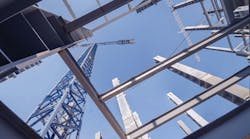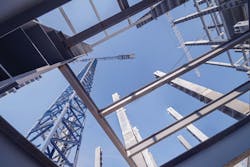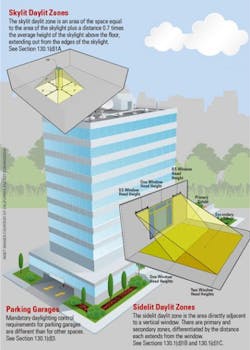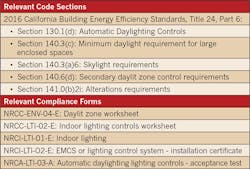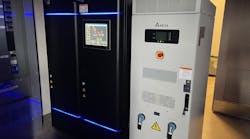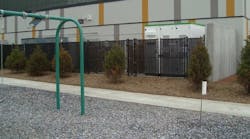Codes and standards aimed at moving the needle on construction of more energy-efficient buildings continue to evolve. And the coming year not only ushers in some new and revised rules, but promises, like clockwork, progress on the next round of updates slated to take effect in 2018 and beyond.
Across the regulatory landscape there’s an emphasis on modernizing, shoring up, and, in some cases, better aligning standards to ensure more uniformity and conformity. Code crafters seem intent on tackling new challenges and tougher obstacles to improved efficiency, tweaking a roster of guidelines that are taking root as respected blueprints for creating the next generation of energy-efficient buildings. From more established ones like the International Code Council’s International Energy Conservation Code (IECC); the ANSI/ASHRAE/IES 90.1 standard, and the U.S. Green Building Council’s ambitious LEED standard, to comparatively newer and more ambitious entrants like California’s Title 24 Building Energy Efficiency Standards (Title 24), the International Green Construction Code (IgCC), and the California Green Building Standards Code (CALGreen), they’re all, to varying degrees and in different ways, trying to push the envelope on efficiency.
With much of the low-hanging fruit picked, standards developers have been busy turning over other stones that may reveal new sources of energy savings. Their hope: Find the missing pieces that could take building energy efficiency to new levels, possibly even the still elusive zero-net-energy (ZNE) designation.
As these efforts become codified, they’re ratcheting up the pressure on building developers to not only continue incorporating well-worn paths to energy efficiency but also encouraging them to mine new veins of potential savings. And while they span the traditionally broad mix of building design factors that impact efficiency, a fair number lie in the broad realm of facility electrical infrastructure. That’s one spot where advances in technology, new products, and performance data on new savings strategies are spawning new opportunities to reduce a building’s electricity draw — and to do so as painlessly as possible.
Scrutinizing plug loads. A prime example is a growing emphasis on plug load controls. With few exceptions, codes have been slowly ratcheting up their focus on electricity usage at this more granular, harder-to-manage level. The emergence of more sophisticated and capable control technologies — combined with the growing realization that, in the aggregate, plug loads do matter — has led standards developers to begin addressing this overlooked and perhaps more complicated dimension of building efficiency.
California’s Title 24 standard first addressed plug load controls comprehensively in its 2013 edition. That followed closely on the heels of plug load control requirements that first appeared in the ASHRAE 90.1 standard’s 2010 edition.
Title 24, now recognized as the nation’s leading-edge building efficiency standard, laid out requirements for more controlled outlets across a variety of spaces in many non-residential building types. They address how and where they have to be laid out; how they’re wired and spaced in a structure; what types of controls are acceptable; and how controlled receptacles must be identified.
Requirements remain in force for the new 2016 edition that took effect Jan. 1, 2017. They were tweaked in the new edition to allow for some limited exceptions in applicability. But they generally retain the focus of making plug load controls a mandatory feature of new buildings and those undergoing extensive electrical rewiring or renovations.
Now, with major efficiency codes addressing them (with the exception of IECC), plug load controls are gaining stature as a component of any comprehensive strategy to gain more control over building energy usage. Long overlooked in favor of concentration on reducing energy usage in core building systems like HVAC, plug loads are now receiving more attention due to their contribution to energy usage and growing ability to be better controlled.
“Plug load controls are late to the game because they’re not the largest single consumer of power in a building’s system,” says Marta Schantz, a manager at Waypoint Building Group who supports the U.S. Department of Energy Better Buildings Alliance PPL team exploring issues related to plug and process load control.
Yet plug loads can, in fact, account for a fair share of building energy usage, says another team member, Rois Langner, an architectural engineer at National Renewable Energy Laboratory, and technical lead for DOE’s Better Buildings Alliance Plug and Process Load Technical Solutions team. There’s data showing plug loads account for 30% of a building’s energy usage, she says, an amount ripe for reduction by up to a third if a combination of behavioral changes and reliable physical controls are brought heavily to bear.
“The wedge of the pie for plug loads (as a reducible component of building energy usage) is growing as plug-in devices proliferate and energy usage of other buildings systems has come down to a point where more gains become harder to attain,” Langner says.
Compliance with plug control guidelines could present a formidable detail test for electrical systems designers and installers. For example, to meet the Title 24 requirement for adequate controlled receptacle coverage, one split-wired receptacle (one controlled; the other uncontrolled) must be installed for each uncontrolled receptacle in the hotel/motel room space. Or, as an alternative, one controlled receptacle must be within 6 feet of each uncontrolled one.
Among other requirements governing their deployment, controlled receptacles must be identified as such with a permanent and durable marking — and be linked to motion or occupancy sensors or manually overridable time switch controls to enable automatic shutoff when the space is unoccupied. The 2016 edition, however, adds a requirement that automatic time switches incorporate an override control with a 2-hour “ON” maximum for controlled receptacles, as well as a holiday shut-off feature. To make circumvention harder, the code forbids the use of occupancy sensors that may be incorporated into plug-in power strips.
While plug load control is generating more excitement, and suppliers are responding with products that make it possible, it may be premature to say it will be central to the drive to reach the next frontier of energy-efficient buildings.
Gina Rodda, a principal with Gabel Energy, LLC, a Castro Valley, Calif., consultancy with expertise in building energy efficiency issues, sees a clear growth of interest in addressing plug loads yet a lot of confusion. Their appearance in the 2013 edition of Title 24 “threw people for a loop,” she says, and uncertainty persists as more aggressive enforcement looms. But as more codes appear to be moving slowly in the direction of ZNE buildings, such as Title 24, which has a 2030 target for commercial buildings to be ZNE in the state, plug loads may prove incidental to the effort.
“They’re an easy visual, but we’re not going to save the planet with controlled plugs,” she says. “It helps in the push to establish a culture of thinking more about energy usage, but it’s a small piece in terms of how we get to ZNE.”
Powering down lighting
A potentially bigger factor in reaching the ZNE promised land is building lighting systems — building efficiency codes continue to prioritize them as important targets for energy demand reduction, and tweak requirements to reflect new priorities and realities.
Evolution and refinement of efficient LED lighting technology, combined with the growing ability to deploy sensors and controls, may be spawning more aggressiveness toward lighting on the part of code revisers eager to make greater strides in building energy efficiency. But continued simultaneous advances on the LED technology and controls fronts may actually be yielding more compromises on mandates governing lighting power density (LPD), deployment of controls, and triggers for code compliance.
The newly effective ASHRAE 90.1-2016 standard, for instance, revisits LPD allowances for commercial buildings. After the 2013 revision held off on further LPD reductions, emphasizing lighting controls in a nod to concerns about the impact on lighting quality, the current standard cuts maximum allowable LPD. It’s reduced an average of 20%, depending on the type of building, although some types are not impacted. Exterior lighting is also affected, with reductions on the order of 30% for all zones.
ASHRAE reportedly issued the tougher requirements on LPD because continued advances in LEDs and greater availability offer more assurance that overall lighting quality, coverage, and efficacy would not be compromised.
Language on lighting controls, however, remains a part of the latest ASHRAE standard. Held over from the 2013 version are requirements for 50% design-power, partial-OFF controls in “always-ON” spaces; enhanced daylight-responsive control flexibility for lighting reduction in daylight zones; and a shortened 20-minute trigger for occupancy sensor time delay control.
In other areas, the 2016 ASHRAE lighting requirements are tweaked. For example, the code is slightly more forgiving on retrofit triggers for LPD and automatic shutoffs — going from 10% to 20% of the connected lighting load when lamp-plus-ballast and one-for-one luminaire replacements are done. Also, in open-plan office zones less than 600 square feet, lighting power can be turned to ON automatically in excess of 50% of connected power — an incentive to use luminaires equipped with sensors in those spaces.
In California, architects of Title 24 revisited a host of requirements that targeted building lighting in the 2013 edition. In continuing to bring it more in line with AHSRAE in the new edition and to encourage overall lighting energy use reductions, they reduced LPD allowances. And while they further pushed for deployment of energy-saving control systems, they also provided a path for avoiding them in certain lighting modification scenarios where they had been required.
In lighting alteration projects of a scope that would have triggered the need to install multi-level daylighting and demand-response (DR) controls, the revised standard allows for a bypass if old luminaires are replaced with those that deliver a wattage reduction of either 35% or 50%, depending on the building type. It, along with another change that reduced the complexity of controls needed if lighting retrofits used more efficient lighting, addressed a stumbling block that the 2013 version had erected, says Scott Blunk, associate director of building science with TRC Energy Solutions, which assists the California Energy Commission with code development.
“In the 2013 code, it was pretty easy to trigger the controls requirement for lighting, and so instead of creating more work for electricians it had the reverse effect,” he says. “People were doing unpermitted work or weren’t doing it to meet the standard. So this new way was added to comply with the tenant improvement requirement, where if you meet the wattage reduction requirement, and the LED technology is now there to do that, you can avoid the code’s demand for controls.”
In some circumstances where lighting controls are mandated, the 2016 update lowered requirements. Multi-level controls in classrooms must now have just one stop for the enclosed space between 30% and 70%; automatic daylighting controls are only required if a wiring alteration affects 10 or more luminaries in a primary sidelit or skylit daylit zone; and DR controls are no longer required if the reduced wattage compliance method is used.
Targeting demand response. Title 24, however, still contains language about the need for DR-capable systems. Lighting systems in spaces of buildings of at least 10,000 square feet that exceed LPD requirements must be capable of receiving an electric utility’s DR signal and be able to reduce lighting power of the space to a specified level. At least one existing standards-based DR messaging protocol must be capable of being translated.
While Title 24 hasn’t gone full bore on lighting that integrates DR, future revisions are likely to address it more fully, says Rodda.
“The last cycle introduced lighting controls and the ability to adjust them to the levels of natural light coming in, and now we’re talking more about demand response — there’s been a huge discussion in ASHRAE circles around this,” she says. “With more talk about the smart grid and how loads can be adjusted and energy produced and delivered in a more consistent and efficient way, cost-effective LED lighting and controls will get more attention.”
Codes and standards targeting building efficiency also are being oriented to increased deployment of systems that measure and monitor power usage. A separate electrical power distribution (EPD) section of Title 24 addresses areas such as electrical service metering, separation of electrical circuits, along with plug loads and other types of circuit controls. This growing emphasis recognizes the link between measuring and managing, and may pressure building electrical systems designers and installers to better integrate those capabilities into efficient buildings of the future.
Yet only minor changes were made to EPD system requirements in the latest Title 24 edition. For instance, a metering system provided by the servicing electric utility that indicates instantaneous kW demand and kWh for a utility-defined period now satisfies the code requirement for an owner-provided permanently installed metering system.
The code also requires EPD systems to be of a design that permits disaggregated measurement of energy usage of specified load types. The aim is to generate data that will help buildings owners drill down into load data and better target energy-reducing improvements. The latest Title 24 edition, though, moves away from rigid guidelines on load separation methodologies and permits any of three defined approaches to measuring separate loads. All revolve around the use of panelboards, switchboards, or motor control centers. Branch circuit monitoring technology might grow to become part of the solution as well.
Building efficiency codes have continued to evolve to reflect higher bars for performance and new technologies. Commercial building interests have experienced some whiplash with code revisions; the recent Title 24 rewrite, for instance, was only about 5% more stringent than the 2013 edition, which was about 30% more rigid than its predecessor.
But the future is likely to be just as bumpy, if not more. California’s push toward ZNE buildings, Rodda says, may mean a return to more disruption in the next Title 24 revision cycle. “Codes can’t remain stagnant, but they must show that every measure is cost-effective over the life cycle of the building,” she says.
The steady emergence of renewable energy, microgrids, the smart grid and battery energy storage will factor more into building efficiency, and codes will continue to be retooled to reflect their greater role. Blunk, for one, sees a fundamental change of mind-set ahead.
“Codes are not going to be as much about energy efficiency as they are about grid harmonization,” he says, noting the role that on-site renewable energy is sure to play and the emerging need for buildings to be grid friendly. “We’re running out of rope on gains in efficiency, and there’s some pushback on DR, so one of the solutions is going to be renewable energy paired with battery storage. Storage as a requirement in the code is probably six years away, but in the next three years there will probably be credits available for it in codes.”
Zind is a freelance writer based in Lees Summit, Mo. He can be reached at [email protected].
SIDEBAR: New DOE Transformer Standard Contributing to Building Efficiency
As codes evolve to better address building energy efficiency so, too, do federal standards on building components that consume power or manage power distribution, both major factors in building energy usage.
A case in point is a now year-old U.S. Department of Energy (DOE) standard for distribution transformers. Mimicking evolving DOE efficiency standards on electric motors, a new standard raises the efficiency bar for transformers built after Jan. 1, 2016. That means new, less power-hungry transformers, sometimes overlooked as a source of potential long-term energy savings for buildings, are now finding their way into building applications.
The DOE 10 CFR p431 standard, which took effect Jan. 1, 2016, only incrementally improves the efficiency of covered transformers via reductions in energy loss, but because of a typical three-decade service life, transformers replaced now will deliver potentially significant savings over time.
The DOE standard replaced the 2007 NEMA TP-1 standard for both medium- and low-voltage, dry-type transformers (the kind most often used in building applications) and liquid-immersed transformers used in electric utility applications. Transformers built to NEMA Premium efficiency levels, however, retain an efficiency edge, and may be specified in some efficiency code-guided applications.
With the new DOE standard in place, most distribution transformers manufactured and sold in the U.S. market meet an efficiency standard for transformers promoted by the members of the Consortium for Energy Efficiency (CEE).
“CEE market initiatives frequently use specifications to detail consensus agreement among utilities about what products and systems they’ll promote,” says Jess Burgess, CEE senior program manager. “As the market transforms, technology advances, and federal standards catch up, there’s sometimes a point when it’s not clear how to generate more savings cost-effectively. We’re at that point now with distribution transformers.”
Three-phase transformers are seeing the biggest boost in efficiency, with a 30kVA efficiency measure rising from 97.5% to 98.23%; a 45kVA going from 97.7% to 98.4%; and a 1,000kVA moving from 98.9% to 99.28%.
Higher efficiency, though, is a coming at a price. Covered transformers were predicted to be more expensive due to costlier steel needed for their design; incorporation of more expensive mitred and wound cores; and installation retrofits required because of changed transformer dimensions and weight.
Still, more efficient transformers are expected to deliver significant savings over time, partly owing to the fact they’re always on at 35% average loading. DOE estimates 18% reduction in energy losses in a low-voltage dry-type transformer, and 13% in medium-voltage designs. Over time, those savings could add up, contributing to more comprehensive efforts to slash both building energy usage and related greenhouse emissions. In short, they may play a small but ongoing role in the advance of energy-efficient buildings.
